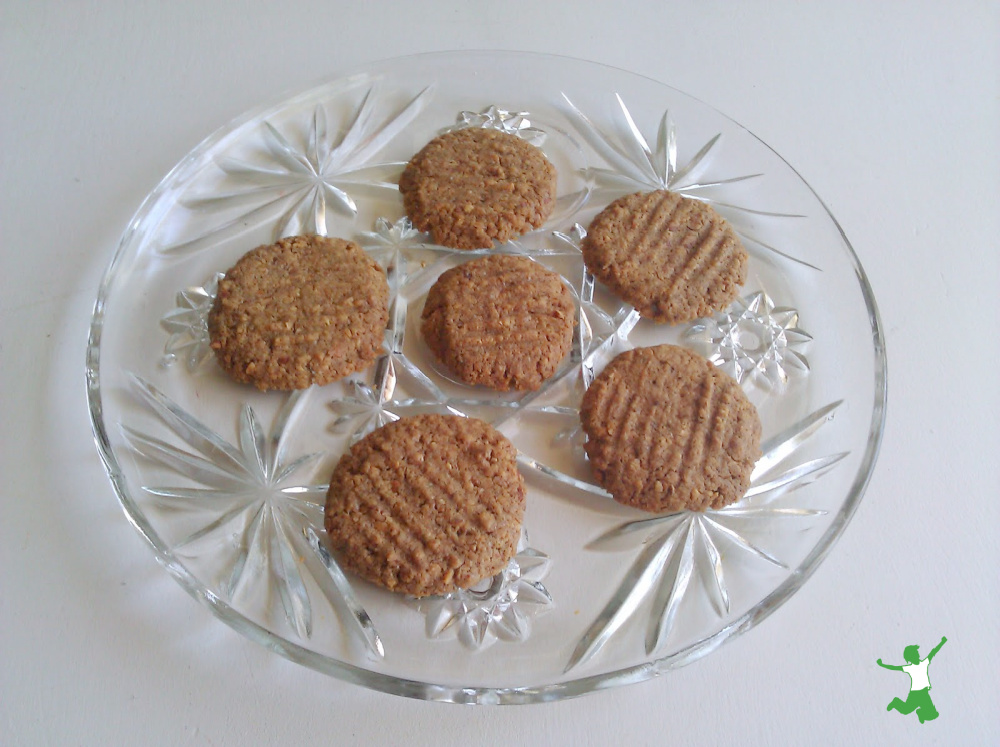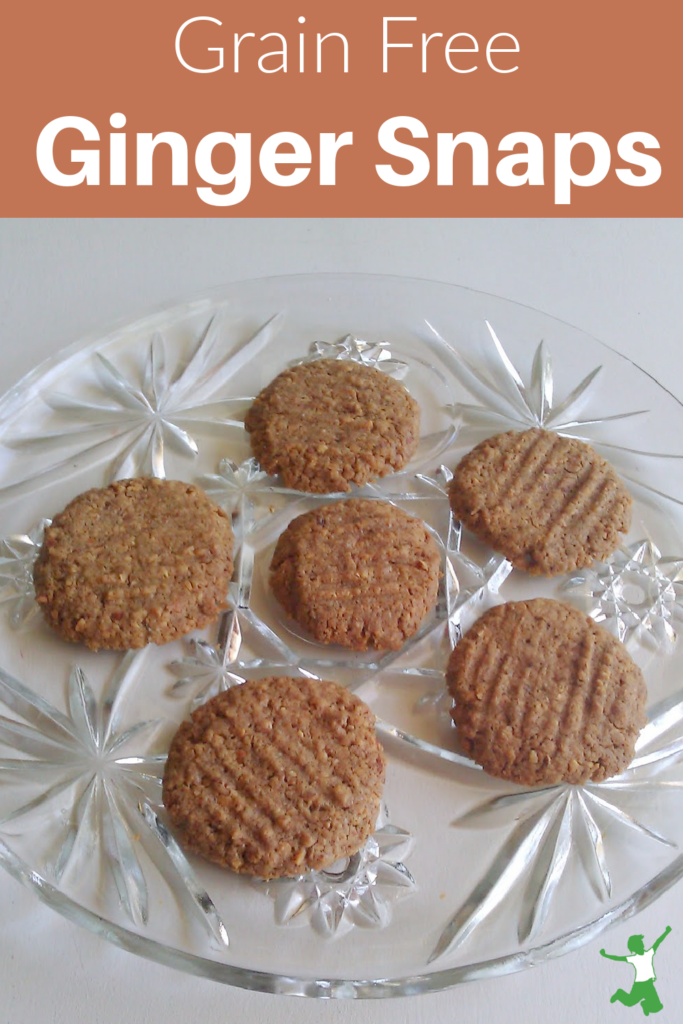Table of Contents[Hide][Show]
Healthy ginger snaps baked deliciously grain-free and delightfully crispy to enjoy as a snack or tucked into lunchboxes.

My family loves ginger snaps, and the fact that our favorite recipe is made with almond flour makes it all the better as this adds variety to the menu.
A big bonus is that these ginger snaps are so fast to prepare and bake!
I keep a bag of homemade almond flour from sprouted or soaked nuts in the freezer most of the time to make grain-free pizza crusts quick and easy.
Preparation and Substitution Suggestions
If you avoid almonds or are otherwise on a low oxalate diet, I think these cookies would be amazing made with hazelnut flour as a tasty alternative that is low in oxalic acid.
I took my inspiration for this recipe from Nourishing Traditions Cookbook, which suggests sucanat as the sweetener.
After making several batches, I found that date syrup is also delicious and works for those who avoid disaccharide sweeteners to improve digestion.
Another tweak I made is to add an egg. This ensures that the cookies hold together well. There are no eggs in this recipe per my edition of Nourishing Traditions.

Homemade Ginger Snaps
Healthy ginger snaps baked deliciously grain-free and delightfully crispy to enjoy as a snack or tucked into lunchboxes.
Ingredients
- 1 1/2 cups almonds soaked or sprouted, preferably organic
- 1/2 cup butter softened, preferably grassfed
- 1 cup arrowroot flour
- 1 egg preferably pastured
- 1/2 cup sucanat or date syrup
- 1 Tbsp filtered water
- 1 1/2 tsp ground ginger
- 1 tsp ground cinnamon
- 1/4 tsp ground nutmeg
- 1/4 tsp ground cloves
- 1/2 tsp sea salt
Instructions
-
Pulse crispy or sprouted almonds in a food processor until they are ground into almond flour. It is not necessary for the almond flour to be extremely finely ground as a more coarse texture works well when mixed with the arrowroot powder.
-
Blend in remaining ingredients. Form into balls the size of a ping pong ball and arrange on greased, stainless steel cookie sheets (I do not recommend parchment paper as it is coated with hormone-disrupting silicone).
-
Bake at 300 °F/ 149 °C for 20 minutes, removing pan from the oven after 5 minutes to press each ball lightly with a fork before baking the remaining amount of time.
-
Cool and store in an airtight container in the refrigerator.









just made these last night and forgot the butter!!! surprisingly, they still turned out really good!
Hi Sarah, can I use anything instead of arrowroot flour?
Thanks
Did you use freshly ground ginger or from a spice jar? Thanks!
Thank you, Sarah. I’m really surprised, since the almond seem to shrink when ground up. I will try it though and see.
I know this is an older post, but I’m wondering if anyone knows the measurement for already-made almond flour. I make my crispy almonds into flour all at once, and then store in the freezer. Thanks!
Hi Bethany, it would be about the same – 1 1/2 cups.
Sarah,
Where do you find arrowroot powder around here in Tampa?
Sarah,
This is my first time posting on your blog, but I have enjoyed reading your posts off and on for a couple of months. Thank you for all of the time and care that you put into this educational effort. I have a question about removing almond skins. Do you blanch and remove the skins before soaking and dehydrating them, or do you leave the skins on? Having recently done GAPS I needed to remove the skins for added digestibility and I found that I preferred the taste of all almond products made without the skins (including basic crispy nuts). But the problem is the labor intensity of removing the skins. Do you have any efficient method of removing the skins of a large volume of almonds? I currently pour hot water over the almonds (about 10-12 cups at a time), let them sit for 20 minutes, and then pop the skins off one by one. Rubbing a towel on them doesn’t work as well as rubber gloves! But it takes FOREVER! I’d appreciate any suggestions!
As of September 1, 2007 the Almond Board of California (ABC) and the United States Department of Agriculture (USDA) made it mandatory for all raw almonds sold to consumers in North America to be pasteurized. The Food and Drug Administration (FDA) is the agency responsible for approving treatment processes.
Currently FDA has approved the following treatments for almond pasteurization:
Oil roasting, dry roasting, and blanching: These processes have been around far longer than the recent almond pasteurization requirements and through the historical techniques they reduce harmful bacteria.
Steam Processing (H2O): There are many different techniques being used throughout the industry that are acceptable forms of pasteurization that even meet the USDA Organic Program standards. Short bursts of steam are shot onto the outer skin of the almond and do not effect the nutritional integrity of the almond. This process does NOT “cook” proteins or destroy vitamins and minerals. The steam does not change the nutritional characteristics of the almonds.
Propylene Oxide (PPO): This too is a surface treatment and does not affect the nutritional characteristics of the almonds. PPO has been used on foods since 1958 and is proven to be very effective at reducing harmful bacteria on the almonds and poses no risk to consumers. PPO residue dissipates after treatment. The Environmental Protection Agency (EPA) confirmed that PPO poses no health risk.
LABELED “RAW ALMONDS” – The FDA, the agency that regulates packaging labeling, has determined that raw almonds treated via Steam or PPO methods may be labeled RAW under FDA guidelines.
ONLY TREATS THE OUTSIDE – Steam (H2O) and Propylene Oxide (PPO) treatments only affect the outside surface of the almond. Unlike juice, milk, eggs and canned foods, raw almonds can achieve equal safety protection against harmful bacteria without affecting the inner core.
WHAT MIGHT I NOTICE? — Many of the industry leaders use the PPO method. It is reasonable in price and is not noticeable to the consumer. Most retail stores and warehouses will sell RAW Almonds that have been PPO Treated. We find that most of our consumers that are looking for “non-pasteurized almonds” are very against the PPO Treatment since it is a chemical process (regardless of the EPA’s findings). Steam (H2o) treated raw almonds might have a slightly different color to them. Especially on the scratched areas on the almond, H20 will dull the bright white scratches, and soften the overall almond. You will notice they are not as crunchy as non-H20 treated almonds.
I made these at Thanksgiving and also used the recipe for a substitute pumpkin pie crust. It was delicious!
That is a brilliant idea — I’m going to try that next year!
you can buy raw almonds via the green smoothie girl website group buy program here. She does this program once a year & it lasts for a few months. It’s been open since November 2010 this time.